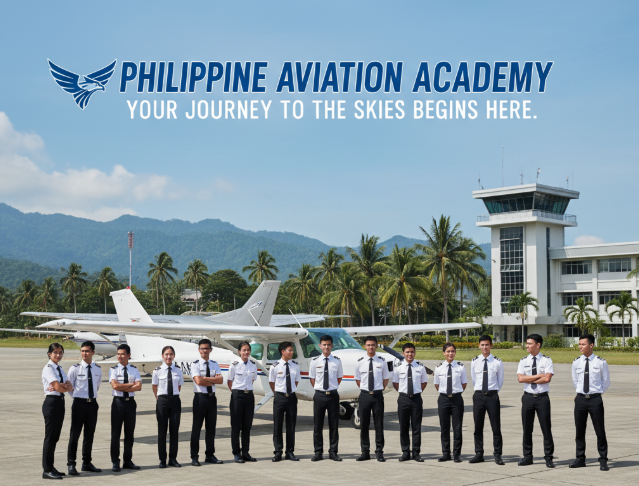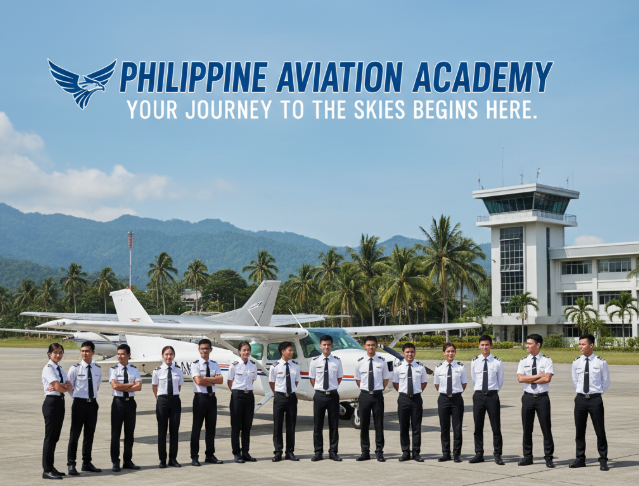
Introduction to Aviation School in Philippines
Aviation schools play a critical role in shaping the future of aviation professionals around the world. In the Philippines, aviation schools and flight academies have seen tremendous growth, becoming a key player in nurturing talented pilots, flight instructors, and aviation professionals. The rise in domestic and international demand for trained pilots, along with the strategic location of the Philippines, makes it an ideal destination for flight training.
An aviation school in the Philippines typically provides a structured, formal education for those seeking to become licensed pilots, flight instructors, or aviation experts. The training involves both theoretical classroom sessions and practical flight experience, equipping students with the knowledge and skills necessary to navigate the skies.
In this article, we explore the intricacies of aviation schools in the Philippines, the opportunities they present, and how these institutions contribute to the global aviation landscape.
What Is an Aviation School?
An aviation school is a specialized educational institution that offers training programs in various aspects of aviation. These schools provide both practical and theoretical knowledge to aspiring pilots and aviation professionals. The main courses offered in aviation schools include:
- Pilot Programs: These are designed to train individuals to become commercial pilots, private pilots, or airline transport pilots (ATP).
- Flight Academy: Offers in-depth flight training, including the operation of aircraft, safety protocols, navigation, and air traffic control.
- Aviation Institutes: These offer a broader spectrum of training, ranging from engineering, air traffic control, and flight dispatch to aviation management.
- Flight Instructor Programs: For those interested in teaching aviation, flight instructor programs help students become certified flight instructors.
Each program comes with a set of qualifications, timelines, and curriculum to ensure graduates are ready for the challenges of the aviation industry.
Importance of Aviation in the Philippines
The aviation industry is integral to the Philippine economy. As an archipelago with over 7,000 islands, the country relies heavily on air travel for both domestic connectivity and international accessibility. In 2019 alone, over 41 million passengers were transported via air, demonstrating the essential role aviation plays in the country’s infrastructure.
The Philippines is home to a growing aviation market with numerous airlines, cargo carriers, and chartered services operating domestically and internationally. Major international airlines, such as Philippine Airlines, Cebu Pacific, and AirAsia Philippines, require a continuous supply of trained pilots and aviation personnel to maintain their operations.
The Philippine government, through agencies such as the Civil Aviation Authority of the Philippines (CAAP), continues to strengthen aviation policies and infrastructure to keep up with demand. In addition to commercial aviation, the country’s military and defense sectors also require skilled aviation professionals, further bolstering the industry’s importance.
History and Development of Aviation in the Philippines
Early Aviation History of the Country
The history of aviation in the Philippines dates back to 1910 when the first successful flight was made by a Filipino pilot, Santiago P. Pilar. Since then, aviation has played a crucial role in the country’s growth and development. In 1941, the Philippine Air Force was established, marking a significant milestone in the nation’s military aviation history.
Milestones in Philippine Aviation
- 1941: Establishment of the Philippine Air Force.
- 1945: The first international commercial flight from the Philippines to the United States.
- 1990: Opening of the Ninoy Aquino International Airport, which became a hub for international flights.
- 2000s: Expansion of low-cost carriers like Cebu Pacific, making air travel more accessible to the Filipino population.
With the increasing number of flights and airlines, aviation education has evolved alongside to meet the growing demand for skilled aviation personnel. As the industry expanded, so did the number of institutions offering aviation-related programs, thus marking the rapid development of aviation training in the Philippines.
Current Role of Aviation Schools in the Philippines
Aviation schools in the Philippines are now central to the country’s aviation industry. These institutions offer comprehensive programs that prepare students for careers in both commercial and military aviation. From flight training to ground operations, these schools provide a pathway to success in the aviation field.
Aviation schools serve a variety of roles:
- Pilot Training: They are primary sources for producing commercial and airline pilots.
- Air Traffic Control: Many schools offer training for air traffic controllers, which is essential for managing airspace in the Philippines.
- Maintenance and Engineering: Institutions also train aviation engineers and technicians to maintain aircraft, ensuring safety and compliance with global standards.
- Flight Instructors: Many graduates from aviation schools in the Philippines go on to become certified flight instructors, passing their knowledge and skills to the next generation of pilots.
These schools play a crucial role in meeting the staffing needs of airlines, the military, and other sectors like air cargo and even space exploration.
Eligibility, Training, and Skills Required
To become a pilot or an aviation professional in the Philippines, certain qualifications must be met. These include:
- Basic Qualifications
- Education: A high school diploma is required, though most aviation schools prefer candidates with a bachelor’s degree. In addition, many schools require students to have completed specific subjects like mathematics, physics, and English.
- Health: A medical certificate from a licensed aviation medical examiner is required to ensure the candidate is fit for flight.
- Age: Candidates must be at least 17-18 years old to begin flight training, with no upper age limit for those pursuing careers in aviation.
- Technical Skills
- Navigation: Understanding how to navigate aircraft safely, including using flight instruments, charts, and GPS.
- Meteorology: Knowledge of weather patterns, how to read weather reports, and how to respond to changing weather conditions.
- Aircraft Systems: Understanding how aircraft systems work, from engines to electrical systems.
- Soft Skills
- Leadership: Pilots and flight instructors must possess leadership qualities, including the ability to manage teams, make critical decisions, and handle stressful situations.
- Communication: Effective communication with crew members, air traffic controllers, and passengers is essential for safety.
- Problem Solving: The ability to remain calm and think critically during emergencies is crucial in aviation.
Institutes, Academies, and Training Centers in Philippines
Several prestigious aviation institutes and training centers are located throughout the Philippines. These include:
- Philippine State College of Aeronautics (PhilSCA): One of the most recognized government-run aviation schools, offering comprehensive programs in pilot training, air traffic control, and aviation management.
- Asian College of Aeronautics (ACA): Known for its robust programs in flight training, aviation engineering, and air traffic control.
- Aeron Aviation School: Located in Davao City, Aeron provides pilot training and maintenance engineering courses.
- Pilipinas Jet Training School: Offers both ground school and flight training, focusing on private pilot and commercial pilot programs.
- Cebu Pacific Air Academy: A subsidiary of Cebu Pacific, this academy focuses on producing future pilots for the airline.
- Airlink International Aviation College: A premier aviation school that provides training for pilots, flight attendants, and aircraft maintenance technicians.
These schools are supported by governmental initiatives that ensure the safety, reliability, and sustainability of the aviation industry in the Philippines.
Technology and Innovation in Aviation Training
The integration of new technology into aviation training is transforming the industry. In the Philippines, aviation schools are leveraging cutting-edge tools such as:
- Flight Simulators: To provide realistic flight experiences and training in a safe environment.
- AI in Space Travel: Filipino aviation schools are exploring the role of artificial intelligence in aircraft navigation and space travel.
- Digital Cockpits: To train students in the latest cockpit technology used by modern aircraft.
Global aviation agencies like NASA, ISRO, and the European Space Agency (ESA) are setting the stage for innovations that could influence training programs in the Philippines, particularly in aerospace and space exploration.
Challenges Faced in Pilot Training in the Philippines
Despite the growth of aviation schools in the Philippines, there are several challenges that aspiring pilots face:
- Infrastructure Gaps: Some training facilities lack modern equipment, which can delay the progression of students.
- Cost of Training: Pilot training is expensive, with costs often exceeding PHP 1 million (USD 20,000), which can be a significant barrier for many students.
- Regulatory Hurdles: There are complex regulatory requirements that students must navigate to ensure they comply with both national and international aviation standards.
- Brain Drain: Many pilots trained in the Philippines seek employment abroad, leading to a shortage of qualified aviation professionals in the country.
Future of Aviation School in the Philippines
The future of aviation schools in the Philippines is bright, with several emerging trends shaping the industry:
- Space Tourism: As private companies like SpaceX and Blue Origin pioneer space tourism, the demand for trained pilots and engineers will increase.
- AI in Cockpit Training: AI-based systems for flight training are revolutionizing the industry, offering students new ways to learn.
- National Projects: Philippines is working on national projects like the Gaganyaan mission to send Filipinos into space, opening up opportunities in space exploration.
Career Path & Opportunities
To become a pilot in the Philippines, a typical path includes:
- Education: Start with a basic aviation course or a degree in aviation.
- Pilot License: Obtain a private pilot’s license (PPL), then move on to a commercial pilot’s license (CPL).
- Advanced Training: Complete additional training for airline transport pilots (ATP).
- Job Placement: Many graduates work with local airlines or charter companies before progressing to larger, international carriers.
The average salary for pilots in the Philippines varies, but experienced commercial pilots can earn between PHP 50,000 to PHP 150,000 per month. Opportunities for career advancement in the Philippines and abroad are abundant.
FAQs (10-12 Q&A)
- How much does pilot training cost in the Philippines?
The cost varies depending on the institution, but it generally ranges from PHP 1 million to PHP 1.5 million. - Which is the best aviation institute in the Philippines?
The Philippine State College of Aeronautics (PhilSCA) is considered one of the best institutions for pilot training. - What qualifications are needed for pilot training in the Philippines?
A high school diploma, medical fitness, and the ability to pass written exams are required. - Is international flight training available in the Philippines?
Yes, many Philippine aviation schools offer internationally recognized training programs. - What is the future of aviation in the Philippines?
The future looks promising with the expansion of air travel, space tourism, and technological advancements.
Conclusion
Aviation schools in the Philippines are the cornerstone of the country’s aviation sector. With a rich history, growing industry, and top-tier training facilities, aspiring pilots and aviation professionals have the opportunity to gain world-class training. Whether you’re considering a career as a commercial pilot, air traffic controller, or flight instructor, the Philippines offers a dynamic environment to kickstart your aviation career.
